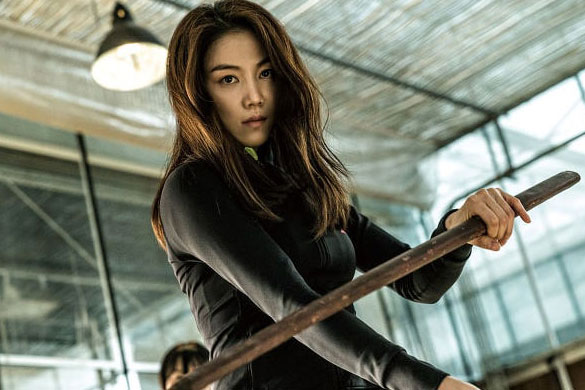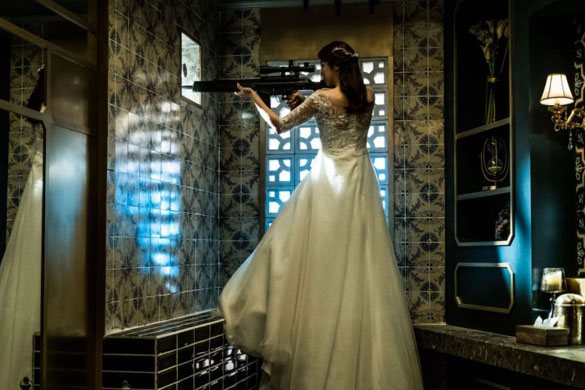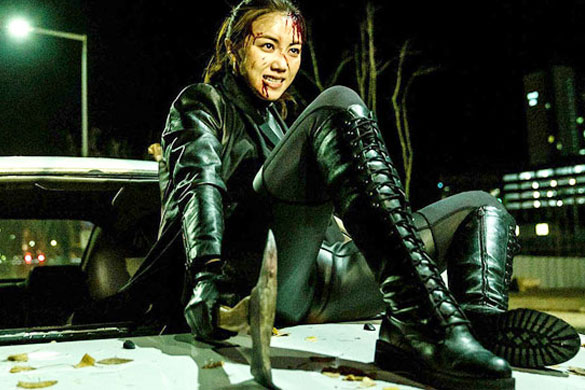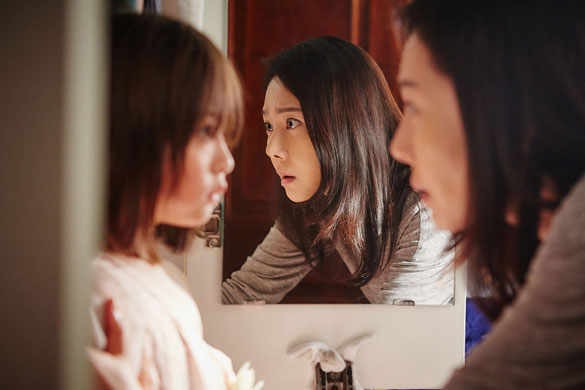(Click the above 'LKFF News' and 'LKFF Interviews' links to access the other pages of this site subsection dedicated to the 2017 London Korean Film Festival)
LKFF2017 REVIEWS:
*All other reviews can be found in the main 'Reviews (Korean Films)' section of this website - see the link at the base of the Hangul Celluloid banner above*
The Villainess screened as part of the London Korean Film Festival 2017 Teaser Screening series in the lead-up to the festival itself:
 |
"To be or not to be, that is the question. That bitch is also questionable..."
Synopsis:
Having bloodily shot, sliced and diced her way singlehandedly through an entire building of gangsters/meth dealers, leaving not a one standing or indeed breathing, Sook-hee (Kim Ok-bin) is given little option by authorities but to join an elite group of Secret Service assassins; being told if she gives them ten years she'll then be allowed to walk away and live a normal, quiet life. Having been pregnant at the time of her initiation, Sook-hee soon gives birth to a daughter and the decision is taken shortly thereafter to send her out on her first mission under the watchful eye of Hyun-soo (Sung Joon), an agent Sook-hee is led to believe is just a random neighbour.
As the two spend time together, they invariably get closer and gradually move towards beginning a romantic relationship. However, Hyun-soo is unaware that not only has Sook-hee a dark, complex and indeed violent past but she also has an agenda in trying to find the man who killed her father, to take retribution and exact her bloody revenge...
Review:
The Villainess hits the ground running from the very outset as we're thrown headlong into pulse-poundingly violent, blood-spattered scenes (or, considering the amount of blood spilled, perhaps blood-soaked would be a more apt description) of Sook-hee hacking, tearing and bludgeoning her way through thug-filled corridor after stairwell after room. Lasting a full eight minutes before Sook-hee, blood running down her face, exits the building into an alleyway during a torrential downpour to be ‘greeted' by hoards of police (her stern blood-streamed look turning to a manic grin), these scenes are strikingly, intricately choreographed and perfectly enacted to definitively show early on what we'll come to realise is the film's ultimate raison d'être. That is, to provide action that will not just keep you on the edge of your seat but virtually knock you off it. However, I was less enamoured by director Jung Byung-gil's decision to film the first half of these scenes POV-style from Sook-hee’s perspective. To my mind, this at best comes across as a rather overly obvious gimmick the novelty of which quickly wears off and at worst risks leaving viewers feeling they're in the middle of a first-person-shooter video game rather than a vengeful woman's fight to the death. Thankfully, a change to normal perspective does come – brilliantly brought about as a result of Sook-hee's head being smashed into a mirror – allowing viewers to see that the action can and does speak for itself, without the need for angle contrivance.
A frankly insane motorbike battle complete with sword fight and an equally frenetic car chase which sees Sook-hee driving a car ‘pedal to the metal’ while perched outside on the bonnet with an axe are the two other most memorable action set pieces present. In fact, they are the strongest segments of the film as a whole but there is ultimately a downside to this kind of ‘by the seat of your pants' action. That is, that in quieter scenes especially supposedly emotional segments centred on the relationship between Sook-hee and Hyun-soo the narrative slows noticeably to the extent that at times it kind of feels like proceedings have almost ground to a halt. If those relationship scenes had been more effective (more on that shortly) perhaps that would have been less of an issue but a lack of character depth on more than one occasion left me rather itching for the next fast paced action segment – the sections of the film that really work, helped hugely as they are by one of the most perfectly fitting musical soundtracks in recent memory, mixing rock verging on metal with pounding rhythms and even traditional elements in a wholly memorable manner. Jung Byung-gil has stated publicly that the only CGI used in The Villainess was in the removal of wirework cables.
That fact makes the already stunning action sequences and indeed the cast's seemingly endless physicality all the more remarkable.
 |
Director Jung Byung-gil on numerous occasions also references other films both Korean and international in The Villainess: A corridor battle during the aforementioned POV sequence that feels eerily similar to the famous and indeed infamous hammer fight scene from Oldboy; repeated channelling of La Femme Nikita – and in one instance an almost copying of a scene in the secret assassin training/sniper mission segments; Sook-hee being pregnant (Kill Bill, anyone?); and even the mirroring of aspects of a scene from Jung Byung-gil's previous film, Confession of Murder, with a main character once again involved in a high speed car chase while positioned on the bonnet of fast moving vehicle.
Jung Byung-gil shall we say ‘borrowed’ in a similar manner in Confession of Murder but while such moves are maybe a bit obvious, I personally didn't have that much of an issue with their inclusion. How you personally feel about their use I guess depends on how much you think they help or hinder the narrative and story overall.
Throughout The Villainess, the present day tale of assassination missions and bloody revenge is interspersed with flashback scenes (almost de rigueur for Korean thrillers of late) gradually unveiling Sook-hee's past. These work well enough when all's said and done, creating an overall story complex enough to be fairly engaging, but what's missing is a much needed depth to Sook-hee's character. Sure, we see her witnessing the murder of her father which ultimately sets her on her path for revenge but we're never shown how the shocking event changed her from who she was or wasn't before.
Why's that important? Well, to my mind, it hits (or should I say misses?) on two levels:
Firstly, in relationship scenes where we need to be able to invest in the character of Sook-hee it rather feels like we hardly know her as a person at all. Add to that the fact that Sook-hee and Hyun-soo constantly lie to each other in either word or by omission (he about being, in truth, an agent who has been tasked with keeping her under surveillance; she about her past) and their relationship can hardly help but feel somewhat fake, more like a quickly written TV series romance than believable cinematic romantic drama scenes.
 |
Secondly, not knowing as much about Sook-hee as a person somewhat affects the film's standing in relation to the female revenge trope in Korean cinema as a whole:
Revenge has long been a major staple of Korean film narratives, having not only been noticeably prevalent for almost as long as references to violence itself but also through the years having served as both its cause and effect. Within the plethora of male-centric 'mano a mano' tales of violent retribution - from 'Oldboy' to 'The Chaser' to 'I Saw the Devil', and all points in between - detailing revenge as a payment in kind of sorts for male brutality, abuse, torture and/or murder of (as often as not, helpless and largely innocent female) characters, there have been regular examples too of women exacting feminine vengeance against specific males, in context, and by extrapolation against the male species in general.
However, though the repeated appearance of these stories of female retribution over the years without question speaks of the gradual shift in place of women in Korean society and the slow, often difficult, move towards balance of the sexes as opposed to traditional patriarchy (and by the same token in each slightly different case serving to underline the gradual change in depictions of female characters in Korean cinema narratives, in the process), it can hardly be denied that - contrary to the majority of stories of male-oriented retribution - in numerous cases female characters taking revenge undertake their vicious quest only after having lost semblance of rationale allowing them to ignore any question of moral right to concentrate on whatever action they feel is warranted (necessary) to exact justice for the wrong they and/or their loved ones suffered. Of course, this isn't always the case (take 'Sympathy for Lady Vengeance' as a contrasting example of a woman who clicks instantly back into normality once her vengeance is successfully concluded) but thrillers such as 'The Housemaid' (1960); 'Diary of June'; 'Princess Aurora'; 'Bedevilled'; 'Azooma' (and the list goes on) or even the endless horror stories of vengeful female ghosts (too many to mention); etc. etc. stand as pointers to the numerous cinematic instances in which the terrible events female characters are subjected to cause an implied yet unmistakable mental trauma and twist leading directly and consequently to utter fanatical obsession with bloody retribution at any and all cost. Whether you agree with the repeated use of these tropes and the often veiled societal implications they bring, almost inherently stated between narrative lines, it can hardly be denied that all of the above examples - and an absolute plethora of others - speak of ongoing issues and even tavesties that continue to be faced by women as they slowly, painfully move towards equality within Korean society. In short, sometimes madness can only be battled by madness.
Ultimately, this thematic prevalence remains, and remains important, regardless of whether you choose to see its continuing appearance as largely a deeply set, repeated - yet often veiled - reiterating of classic Korean Cinema depictions of feminine individuality from as far back as the Golden Age (female outspokenness and indeed sexuality as a destabilising thorn in the side of traditional patriarchal ideals); cite it as part of the gradual shift towards stronger female characters in Korean cinema as a whole, as has been seen in various genres in the last few years; or treat it as simply an eminently useful narrative trope adding societal background, context and even explanation to female violence.
However, in the case of The Villainess, the fact that we only ever so briefly see Sook-hee as a child prior to her father's death and the decision to have the majority of flashback scenes show her being trained - post his death - to become who she in the present is (rather than showing her mental journey or degradation, if you like, from balanced to revenge-obsessed) means that The Villainess is unable to really say anything about female revenge thematically, neither in realtion to ongoing societal issues faced by women in spite of their supposed changing place within Korea as a whole nor indeed in feminism/individuality terms. Sure, Sook-hee is on a vengeance trip but she's a person seeking revenge who just happens to be a woman rather than being a poster girl for female revenge as a trope... and that to my mind is a bit of a shame.
 |
Summary:
While the action set pieces of The Villainess are frankly incredible, a lack of character depth largely prevents the film from saying much thematically. The character of Sook-hee is certainly on a vengeance trip but she's a person seeking revenge who just happens to female, rather than speaking specifically of female revenge in Korean cinema.
THE VILLAINESS (악녀) / 2017 / Directed by Jung Byung-gil
|
All images © Next Entertainment World, Arrow Films
Review © Paul Quinn
|
| |
 |
"My mother used to say: 'If you hear the voices of the dead, it’s nearby'..."
Synopsis:
With her mother, Soon-ja (Hyo Jin), increasingly suffering from memory problems, having seizures and all too often not taking her medication, Hee-yeon (Yum Jung-ah) decides to take her back to Mt Jang where she lived in her younger days in the hope that the familiarity of the surroundings will help her condition improve. No sooner have Hee-yeon, her husband Min-ho (Park Hyuk-kwon), her daughter Jun-hee (Bang Yu-seol) and her mother moved in to their new home than the body of a woman is found in a nearby Mt Jang cave at almost the same time as Hee-yeon finds a dishevelled and seemingly abandoned young girl (played by eight-year-old Shin Rin-ah) in a tattered, faded red dress cowering behind a tree in the surrounding woods. As the police begin an investigation into the woman's death, Hee-yeon takes the child home to look after her in the interim. However, Hee-yeon’s suspicions are raised when the child begins to mimic her daughter (claiming her name is Jun-hee, too), her qualms quickly turning to fears when police show her a photo from a similar investigation way back in the 80s... a picture in which the same young child can clearly be seen, in the very same faded red dress...
Review:
Before dissecting the film per se, note of course must really be made of the fact that the main adult female role in The Mimic is played by Yum Jung-ah, an actress who has been a constant and prominent presence in Korean cinema from the early 90s right through to the present day. In her lengthy and prestigious acting career, Yum Jung-ah has taken roles in films from virtually every genre you could possibly mention – melodramas such as Sad Movie; fantasies like Woochi; social dramas including Cart; and the list goes on, almost ad infinitum – there was one genre in particular during the New Korean Cinema wave of the late 90s and early 2000s that her name became absolutely synonymous with. That genre was, and is, horror.
Horror was without question one of the strongest genres of the entire NKC wave to the extent that even somewhat smaller titles regularly came to be considered both seminal and classic. Not only that, but the fact that directors who would soon become the biggest in the business – Park Chan-wook, Kim Ji-woon – made forays into the horror genre casting Yum Jung-ah in significant roles largely cemented her place as an absolute NKC wave horror movie icon. For fans of, and those with an interest in, classic and indeed important films from the NKC wave, Tell Me Something, H and probably most famously Kim Ji-woon's A Tale of Two Sisters should all feature prominently in Korean DVD collections and all star Yum Jung-ah, and that’s even before we mention her noteworthy role as a vampire in Park Chan-wook’s short (entitled Cut) for the Three Extremes anthology.
Long story short, Yum Jung-ah has been and always will be one of Korean cinema's major Scream Queens, to the extent that for me at least she will always practically define the genre, and it her by the same token. As such, her return to the genre in The Mimic had me, for one, practically salivating at the prospect of her bringing her horror filmography right to the present and hopefully taking it to the next level, in the process.
 |
In early scenes showing a couple taking a bound and gagged woman in the boot of their car to the Mt Jang cave where the man of the two plans to kill her, The Mimic at first comes across as fairly likely to be standard Korean horror/thriller fare. I'm not saying that's a bad thing, particularly, and it does work fairly well but accept it or not even this early on that pales into insignificance when compared to the genuine creepiness that pervades the entire film. In these early scenes, that creepiness takes the form of the disembodied mimicking of earlier character (dead and alive) dialogue with the camera frame inching achingly slowly towards a wholly dark, makeshift hole in a wall within the cave, underlining the undeniable fact that there is something more (and far more foreboding) than just a dead body within.
As the main story begins and the narrative focus moves to Hee-yeon, her family and the odd little girl, we realise the opening couple killing the woman and hearing the voices of the dead was just one of many strange occurrences taking place at the cave over the years but the feeling of creepiness has been firmly placed in our subconscious minds. So, by the time the young girl starts mimicking Hee-yeon’s daughter, sounding just like her and referring to Hee-yeon as ‘mummy', the foreboding mood has already been set, leaving me for one constantly feeling that the hammer could deliciously and violently fall at any time, so to speak.
There are, of course, a number of jump scares throughout The Mimic and many are genuinely scary - one in particular featuring a shaman character and Hee-yeon’s daughter almost made me bite off my tongue. Likewise, numerous scenes featuring the little girl are tense in the extreme (for example, one scene in which she's seen cowering in a dog's cage - jagged, sharp and pointed shard of glass in hand - had me on and beyond the edge of my seat. However, The Mimic, to my mind, is as much about the psychological inability of Hee-yeon to move on from a tragedy; her projecting of her needs onto the girl without even realising; and the resultant vulnerability that almost invites manipulation. As such, The Mimic stands as easily beside noticeably understated – and often underrated – classic psychological Korean horrors such as Acacia (2003), The Uninvited (the 2003 Korean film starring Jeon Ji-hyun, not the lacklustre US remake of A Tale of Two Sisters), and to a degree Sorum (2001) regardless of how memorable you ultimately find the film to be.
 |
In the past few years, there have been a seemingly ever-increasing number of Korean films detailing shamanism, with many focusing on it as an absolute force for good and highlighting its spiritual importance in moving passed-on souls onto their final journeys. The Mimic, too, has shamanism as a major theme but from a wholly different and far darker perspective, as was the case in Na Hong-jin's 2016 horror tour de force The Wailing. However, speaking of, there is a shamanism scene in The Mimic that, certainly in my opinion, has too much in common with a particular Wailing scene. Okay, a shamanistic ritual with all its frenetic intensity is kind of what it is at the end of the day, I guess, but these similarities so soon after The Wailing left me being almost reminded of Na Hong-jin's seminal horror throughout the entire scene. Regardless of how strong you feel The Mimic is overall, it isn't The Wailing and it isn't directed by Na Hong-jin and as such any of those kinds of almost enforced thoughts don't do The Mimic any particular favours. If I hadn't seen The Wailing that wouldn't have been an issue and The Mimic’s scene wholly works in its own right, but frankly what Korean horror fan hasn't seen Na Hong-jin's soon to be considered classic? There is also a fair bit of narrated flashback that serves as exposition in the film's latter stages but I am aware that the overuse of expositional narration is rather a personal bug bear of mine and it's likely few others, if any, will have any issue with that at all.
Considering the psychological aspects of The Mimic’s narrative and the strength of the internal debate as to whether the mimicking child is ultimately a force for evil or as much a victim as Hee-yeon, the importance of the performances of the two actresses and indeed the believability of their interactions is absolutely paramount. From her earliest scenes, Yum Jung-ah shows to the nth degree why her career has continued across more than 20 years, continually going from strength to strength. You only have to watch her break down in the early stages of The Mimic as she argues with her husband to physically feel her character’s pain to a heartbreaking degree and instantly be reminded of how truly talented she is. And as for eight-year-old actress Shin Rin-ah: Her performances in her quickly growing filmography – from Ode to My Father, to The Last Princess, to Memoir of a Murderer) have all been utterly exemplary and wholly memorable regardless of how large, small or supporting they've been. Her major performance in The Mimic takes her career to the next level and I without hesitation state here and now that she's destined to be a massive star.
Finally, and this almost goes without saying, considering the superlative performances of both Yum Jung-ah and Shin Rin-ah, the chemistry between the two is absolutely palpable. You only need to see the aforementioned scene in which the child cowers with a glass shard to realise that the interactions between this veteran actress and an up and coming newcomer with talent way beyond her years are the strongest, the most memorable and the most absolutely rewatchable elements of a genuinely scary, creepy Korean horror.
Ultimately, after a fairly long period which saw Korean horror laying in the doldrums, in the past few years the genre has been resurging, reinventing and once again going from strength to strength. The Mimic successfully underlines that rise and growth and that frankly bodes hugely well for the future.
Summary:
The Mimic is at times genuinely scary, at others deeply creepy, but it is the phenomenal performances of veteran actress Yum Jung-ah and eight-year-old newcomer Shin Rin-ah – and indeed the sheer, palpable chemistry within their interactions – that will ultimately stay with viewers long after the credits roll.
THE MIMIC (장산범) / 2017 / Directed by Huh Jung
|
All images © Next Entertainment World, Arrow Films
Review © Paul Quinn
|
| |
|


